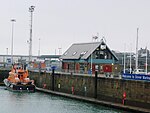Archcliffe Fort

Archcliffe Fort is a former military installation in Dover, England. It is situated at the base of the Dover Western Heights and overlooks the approaches to the port of Dover. A watchtower was erected on the site in 1370 but this was replaced with a more substantial fort by Henry VIII by 1539. The fort fell into disrepair but was renovated in 1588 due to concerns over the Spanish Armada. The Stuart kings James VI and I and Charles I made improvements to the fort and it was heavily garrisoned by Charles II in the aftermath of the 1660 Stuart Restoration. Invasion scares during the long eighteenth century saw further improvements to the defences. The fort was manned during the First World War but in the 1920s much of it was demolished to allow for improvements to be made to the South Eastern Main Line railway. The fort was deemed obsolete by the time of the Second World War and was decommissioned in 1956, after which further demolition took place to widen the A20 road. The surviving structure includes two ramparts and two complete corner bastions, together with some modern buildings in the interior. The fort is used by the Emmaus Community to house formerly homeless people and operates a furniture workshop and retail centre.
Excerpt from the Wikipedia article Archcliffe Fort (License: CC BY-SA 3.0, Authors, Images).Archcliffe Fort
Hawkesbury Street,
Geographical coordinates (GPS) Address Nearby Places Show on map
Geographical coordinates (GPS)
| Latitude | Longitude |
|---|---|
| N 51.115 ° | E 1.3072222222222 ° |
Address
Hawkesbury Street
Hawkesbury Street
CT17 9EG , Clarendon
England, United Kingdom
Open on Google Maps









